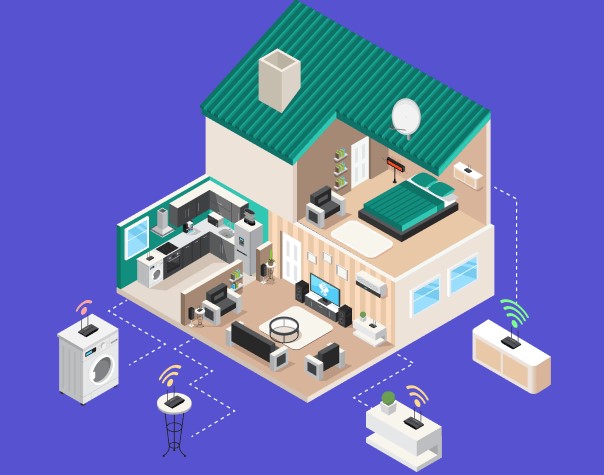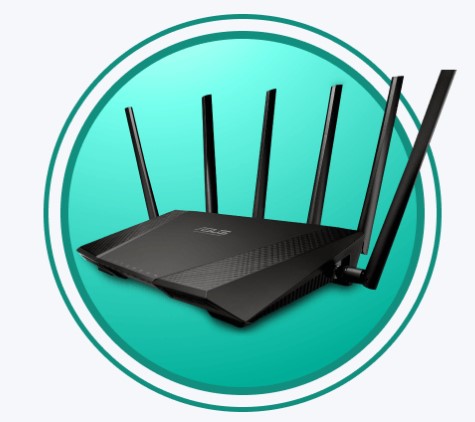Wi-Fi is one of the most important things in our daily life. It is as important as water and electricity. Unluckily, it can be far more unpredictable. The speed of the Wi-Fi may vary from one day to another or it never gets the speeds promised by the ISP. If you are tired of the weak internet connection and want to increase the Wi-Fi signal, here are 5 ways to do so.
Method 1: Choose a good place for your router
Some places may not be suitable for the router. If you want to strengthen or increase your Wi-Fi signal, you will need to avoid placing the router close to metal objects and appliances that radiate the electromagnetic waves. Metal is the number one disrupter of a Wi-Fi signal, and its existence close to a Wi-Fi router is a nightmare.

Apart from metal, the other materials such as wood, foam, glass, plastic, and cardboard are also included as the ones that can disrupt the Wi-Fi signal. The only difference is their influence of the Wi-Fi signal strength is not that big. In fact, a lot of buildings use metal studs rather than 2×4 wood for the particle board use, and locating the router near them is definitely not a great idea. If you are not really sure, it is better for you to use a handheld stud finder or at least install a stud finder app on your smartphone.
Actually, each household item radiates electromagnetic waves to some degree, including electric razor, circuit breakers, and fluorescent light bulbs. The appliances that radiate the biggest electromagnetic wave are usually found in the kitchen, and some of them are microwave ovens, dishwashers, and stoves. Some other items that can be as problematic as the ones before are tumble dryers, cordless phones, washing machines, and radiant heaters. If there is one or more of them at home, please keep your router as far away from them as possible if you really want to increase the Wi-Fi signal.
Method 2: Get a stronger antenna

Wi-Fi routers mostly have small and weak antennas. It is not like the manufacturers want to shape the budget as effectively as they can, but powerful Wi-Fi antennas tend to have a large body. There is a 10-dB antenna that can be anywhere between 10 to 15 inches tall. It is really big if you compare to the antenna that comes with the router, which is probably just a few inches tall and has around 4 dB gain.
If you think the size doesn’t really matter, then a new and powerful Wi-Fi antenna is the best one to boost the Wi-Fi at home or office without having to buy a new router.
There are a lot of kinds of Wi-Fi antenna, but the only variation that you have to care about is the common antenna known as “rubber duck”. This one can be described as an electrically short monopole antenna that has a springy wire in the shape of the narrow helix, bundled in a either rubber or plastic jacket to make the antenna safe.
These kinds of antennas use the same RP-SMA connector, and there are a lot of different models that you can choose from. Please check Amazon and the other online stores. On top of that, some of them even add a handy extension cable that you can use to place the antenna farther away from the router to achieve optimal signal distribution.
For those who want to boost the Wi-Fi signal, all that you need to do is to purchase an antenna with more gain than the one that you currently have. For your information, the gain of an antenna system relative to an isotropic radiator at radio frequencies is expressed in dBi, or decibels relative to isotropic. The routers at home usually come with small antennas, whose gain tends to be around 4 to 5 dBi. Changing this kind of antenna with a 9 dBi antenna should improve the signal of the Wi-Fi.
Method 3: Change the DNS address

The DNS or Domain Name System is the one that has the responsibility to convert the domain names such as www.google.dom into IP addresses (64.233.160.0). By default, every modem is most likely configured to use the DNS server of the internet service provider, whose performance may not be the best.
Fortunately, most modems allow you to change the DNS address, which is the easiest method to strengthen the Wi-Fi performance. There are a lot of public DNS servers that you are able to select from. Some of them include the DNS server by Cloudflare (1.1.1.1) and the DNS server by Google (8.8.8.8).
If you want to get the best DNS server, you are recommended to download and run the Domain Name Speed Benchmark. This one is a free Windows application that offers you some features to enable the serious DNS performance investigation, and you are free to use it if you want to find the newest DNS server in your area with just a few clicks.
First of all, you will have to download and start the Domain Name Speed Benchmark. Then, switch to the Nameservers tab. In the next step, click the Run Benchmark button. Lastly, go to the tab named Conclusions after the benchmark completes. Once you have selected the best DNS server available, you have to go to the settings of the modem and replace the default DNS address with the DNS address of the new server.
Method 4: Use the newest Wi-Fi technologies

The latest wireless technology called IEEE 802.11ac offers superior download and upload speeds. Besides, it has also improved the range if you compare it to the older ones like IEEE 802.11b.g and the others. If you want to get the benefit from the newest Wi-Fi technologies to strengthen the Wi-Fi signal, you will have to make sure that both the home router and the Wi-Fi enabled devices such as laptops and smartphones support them.
When you choose a new Wi-Fi router with the support for IEEE 802.11ac, you are not recommended to choose the most affordable model that you can find. Unless you really do not have enough cash, spending more to purchase a router with amazing range and modern features such as Quality of Service, gigabit Ethernet ports, MU-MIMO, and replaceable external antennas is always worth it.
A good router usually lasts long and is able to serve you well for at least five years, which equals to how long it usually takes for the major new Wi-Fi technology to be mainstream. If you are planning to get the Wi-Fi routers, the most recommended ones are:
- Netgear Orbi Wi-Fi 6 System AX6000
- Asus ROG Rapture GT-AC5300
- D-Link EXO AC3000 Smart Mesh Wi-Fi Router
- TP-Link AC2300
- Netgear Nighthawk X10 AD7200 Smart Wi-Fi Router (R9000)
Netgear Orbi Wi-Fi 6 system A6000 is not a traditional Netgear router. This one is a state of the art mesh Wi-Fi system that makes it possible for you to cover a big house or office building with a good Wi-Fi signal. You are able to get it with two or three units included in the box and expand it by purchasing the additional satellite unit in the future. Even with the most basic configuration, this one is able to handle over a ton of devices connected at once with ease with the help of the parented tri-band mesh technology of the Netgear with a patented dedicated backhaul. However, it is not really perfect. Just like any other thing, it has a weakness, which is the steep price of the system.
Method 5: Buy a Wi-Fi repeater or booster or extender

Do you know what Wi-Fi repeaters, booster, and extender are? Some people may be confused about Wi-Fi repeaters, booster, and extender, when in fact all of them are basically the same thing.
Wi-Fi repeaters are known as simple devices that take the signal that has been existing from the Wi-Fi router and rebroadcast it as a network. This new one is actually just an extension of the main network, and each data that goes through it also will go through the main network.
Wi-Fi booster and extenders are really similar, but they also strengthen the existing signal before rebroadcasting it to make the second network. Because the Wi-Fi boosters usually have the greater range compared to the Wi-Fi repeaters, they make sense in cases where the original signal is really weak.
A great repeater or booster can be purchased for less than $100, and it is able to be installed in just a few minutes by anyone since pressing the WPS button is usually the only thing involved in the installation process.
If you are not really familiar with Wi-Fi boosters, here are some best Wi-Fi boosters according to the professional review and real users alike:
- Netgear Orbi RBK50
- Netgear Nighthawk X65 EX8000 Tri-band Wi-Fi Extender
- D-Link PowerLine AV1000 Wi-Fi AC Starter Kit
- TP-Link RE350 AC1200 Wi-Fi Range Extender
- Linksys RE7000 Max-Stream AC1900+ Wi-Fi Range Extender
If you are interested in Wi-Fi extenders, some of the best ones include:
- D-Link DAP-1720 Wi-Fi AC1750 Range Extender
- TP-Link RE650 AC2600 Wi-Fi Range Extender
- Netgear Nighthawk X6 EX7700 Mesh Range Extender
- Netgear Nighthawk X4 AC2200 Wi-Fi Range Extender
- Linksys Velop Wi-Fi Extender
If you want to get the best performance when using the Wi-Fi repeater or booster, it is better for you to use a Wi-Fi booster app in order to analyze the existing Wi-Fi coverage and determine the best way to extend the existing Wi-Fi network.
Wi-Fi can be a varied thing. One time you may be enjoying a Wi-Fi with the excellent signal, and when you move just a few steps from the original place, the signal may be dropped to one bar. The performance of Wi-Fi network can be caused by a lot of factors such as:
Obstructions:
The signal of the Wi-Fi can be either partially or completely absorbed by some different kinds of objects and obstacles such as furniture, walls, duct work, home appliances, and even humans. These kinds of blockers have negative effects on 5 GHz Wi-Fi networks because they have higher frequency signals that do not penetrate solid objects nearly as well as lower frequency signals.
Physical distance:
For the safety and technical reasons, Wi-Fi routers do not have the same transmitting power as cell towers. Cheaper routers may have a hard time to cover a relatively small apartment with a strong Wi-Fi signal, so can you imagine the entire house? Feel free to determine the reach of the Wi-Fi router using a W-Fi analyzer app like NetSpot.
Bandwidth hoggers:
In some cases, the issue is not with the strength of the Wi-Fi signal but the capacity of the internet connection. Streaming on more than one device or video chatting can bring even a powerful Wi-Fi network to the lowest case. If you want to get the best experience, it is better for you to manage the bandwidth hoggers and prevent them from stealing the bandwidth from anyone else.
Interference:
The signals of the Wi-Fi occupy the same radio frequency band of the electromagnetic spectrum actual radios, walkie talkies, cell phones, microwave ovens, baby monitors, and a lot of other devices, which all of them can interfere with the signals of the Wi-Fi. It is true that the Wi-Fi networks can also interfere with one another, but an issue that is especially common in apartment buildings and the other populated places.
Router capacity:
As you probably know, not all routers are equally strong, just like some computers that can barely handle casual web browsing and some can render complex 3D objects. No one can reasonably expect a low end router to provide reliable wireless access to the internet to a busy office with more than a ton of employees and a few fax machines, Wi-Fi connected printers, and wireless security cameras.
AUTHOR BIO
On my daily job, I am a software engineer, programmer & computer technician. My passion is assembling PC hardware, studying Operating System and all things related to computers technology. I also love to make short films for YouTube as a producer. More at about me…





